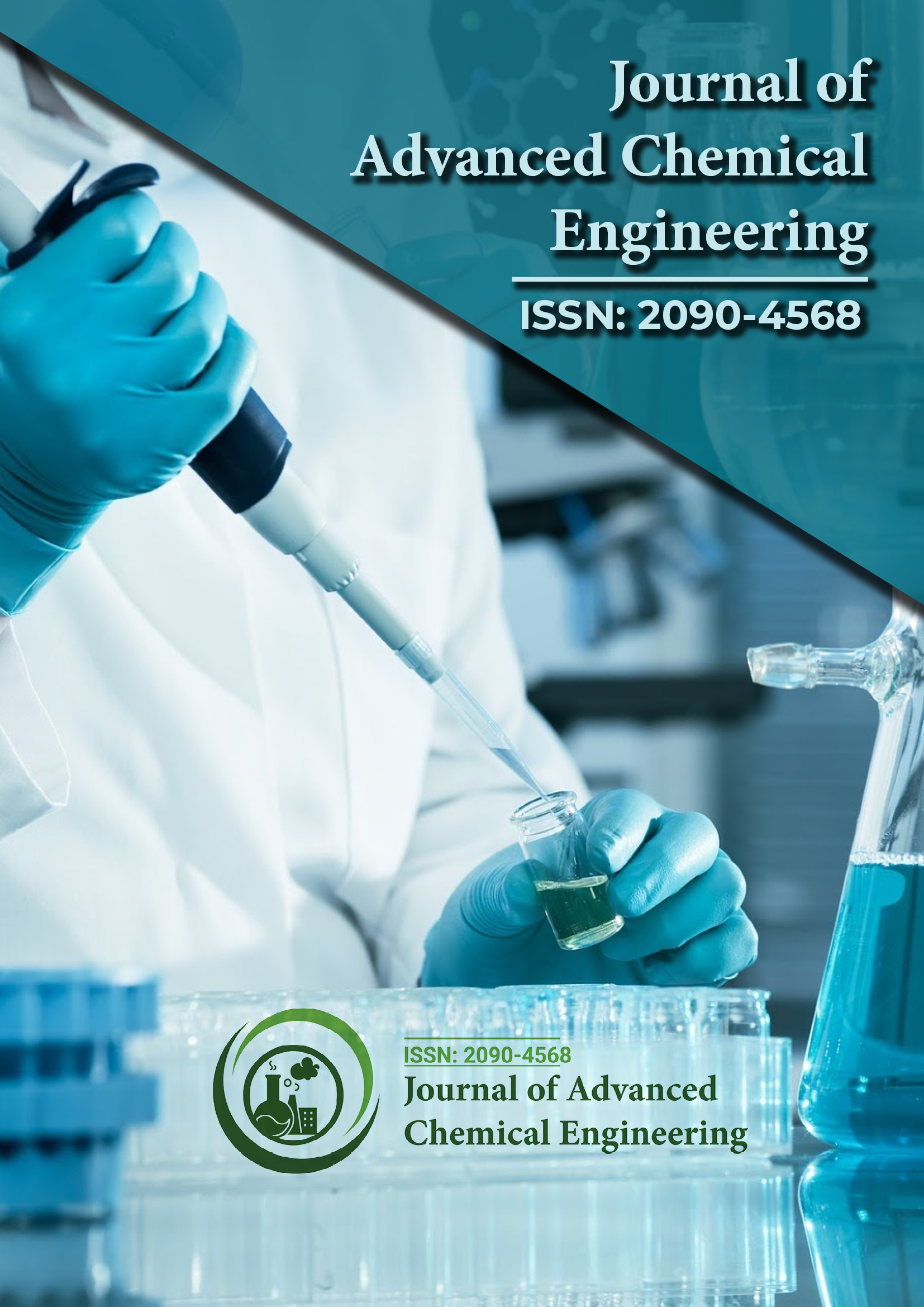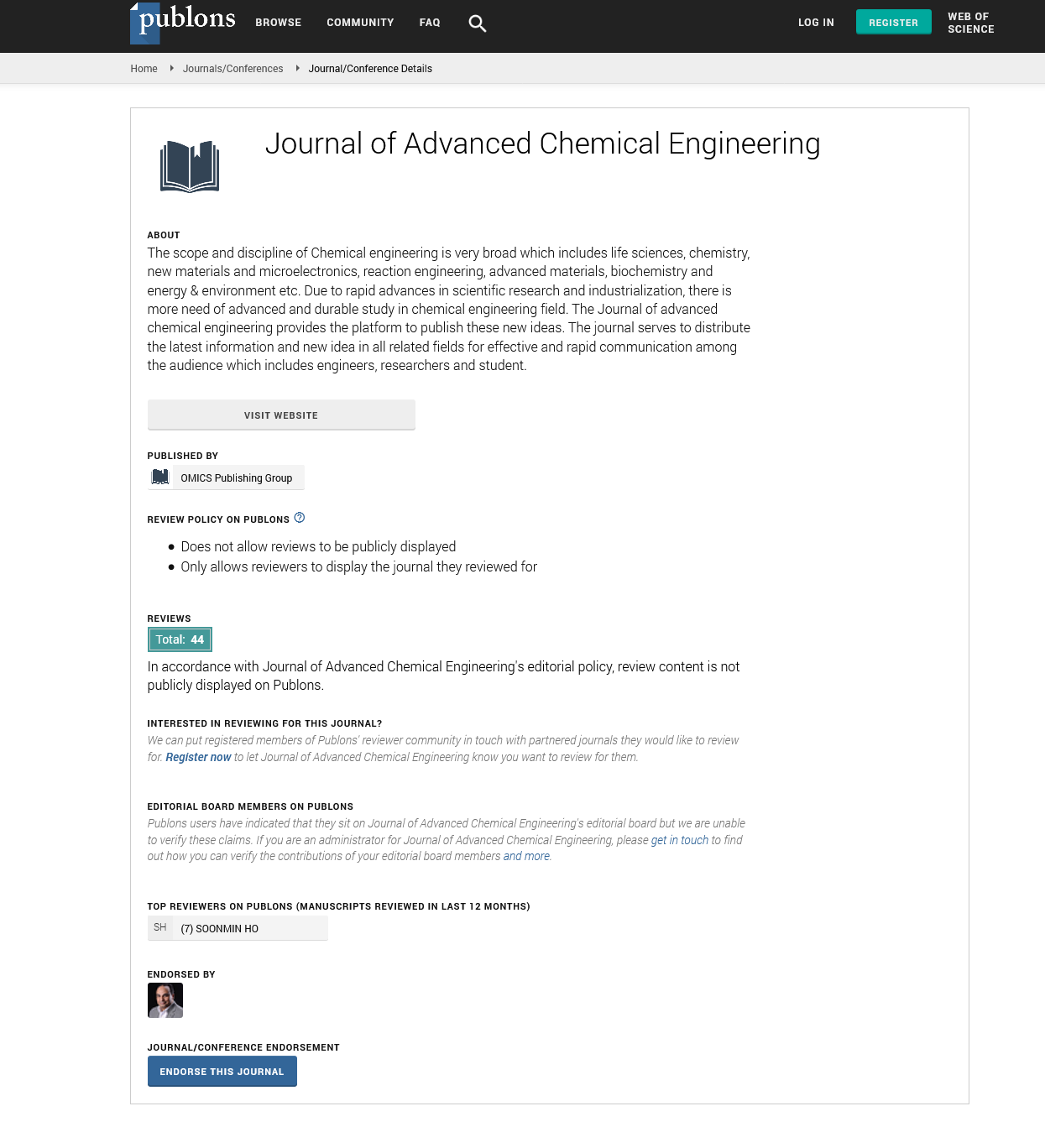Indexed In
- Open J Gate
- Genamics JournalSeek
- Smithers Rapra
- RefSeek
- Directory of Research Journal Indexing (DRJI)
- Hamdard University
- EBSCO A-Z
- OCLC- WorldCat
- Scholarsteer
- Publons
- Geneva Foundation for Medical Education and Research
- Google Scholar
Useful Links
Share This Page
Journal Flyer

Open Access Journals
- Agri and Aquaculture
- Biochemistry
- Bioinformatics & Systems Biology
- Business & Management
- Chemistry
- Clinical Sciences
- Engineering
- Food & Nutrition
- General Science
- Genetics & Molecular Biology
- Immunology & Microbiology
- Medical Sciences
- Neuroscience & Psychology
- Nursing & Health Care
- Pharmaceutical Sciences
Opinion Article - (2025) Volume 15, Issue 1
Bioinspired Catalysts for Industrial Oxidation Reactions: Mimicking Nature for Cleaner Chemistry
Dragan Petrovic*Received: 03-Mar-2025, Manuscript No. ACE-25-29159; Editor assigned: 05-Mar-2025, Pre QC No. ACE-25-29159 (PQ); Reviewed: 19-Mar-2025, QC No. ACE-25-29159; Revised: 26-Mar-2025, Manuscript No. ACE-25-29159 (R); Published: 02-Apr-2025, DOI: 10.35248/2090-4568.25.15.362
Description
Industrial oxidation processes are vital to the large-scale production of chemicals ranging from bulk acids and aldehydes to fine pharmaceuticals and agrochemicals. Traditionally, these transformations rely on harsh reaction conditions, stoichiometric oxidants, and metal-based catalysts, which often generate significant amounts of hazardous waste and consume high energy inputs. Inspired by nature's highly selective and efficient oxidation pathways, researchers have turned to the design of bioinspired catalysts to develop cleaner, more sustainable oxidation processes. These catalysts draw inspiration from natural enzymes such as cytochrome P450, laccases, and peroxidases, replicating their structural features and catalytic mechanisms using synthetic analogs suitable for industrial environments.
Nature’s oxidative enzymes operate with remarkable precision under mild conditions, often utilizing molecular oxygen or hydrogen peroxide as terminal oxidants. Mimicking these features in synthetic catalysts enables chemists to conduct oxidation reactions with minimal by-products, improved atom economy, and lower environmental footprint. Metalloporphyrins and metal-salen complexes are two widely studied families of bioinspired catalysts that emulate the active sites of heme and non-heme oxidases. These complexes, typically centered around iron, manganese, or cobalt, exhibit tunable redox properties and high catalytic turnover, making them suitable for a variety of oxidation reactions such as alkene epoxidation, alcohol oxidation, and C-H functionalization.
In particular, manganese porphyrin catalysts have demonstrated excellent activity in the epoxidation of alkenes using environmentally benign oxidants like hydrogen peroxide or dioxygen. Ligand modifications allow precise control over the electronic environment of the metal center, enhancing both selectivity and stability. Immobilization of these catalysts on solid supports, including silica, polymer resins, and magnetic nanoparticles, has further enabled their recycling and reuse in continuous flow systems. This hybrid approach combines the benefits of homogeneous and heterogeneous catalysis while reducing catalyst leaching and process contamination.
Biomimetic oxidation is also making an impact in the selective hydroxylation of unactivated C-H bonds, a challenging transformation with important implications in pharmaceutical and fine chemical synthesis. Non-heme iron complexes inspired by α-ketoglutarate-dependent dioxygenases have shown potential in oxidizing hydrocarbons with high regio-and stereoselectivity. These complexes operate via radical-type mechanisms similar to their biological counterparts, and they are compatible with a broad range of substrates, including aliphatic and aromatic compounds.
Another area of interest is the development of bioinspired catalysts for aerobic oxidation of alcohols. Utilizing molecular oxygen as a green oxidant, palladium-based catalysts supported by N-heterocyclic carbene or pincer ligands offer high efficiency in converting alcohols to aldehydes or ketones. Efforts are being made to replace noble metals with earth-abundant alternatives such as copper and iron. Copper complexes inspired by tyrosinase enzymes have been successfully used for oxidizing phenols and catechols under mild, aqueous conditions, offering both environmental and economic advantages.
Computational chemistry and mechanistic studies play a vital role in advancing bioinspired catalysis. Density Functional Theory (DFT) simulations help unravel the reaction pathways, transition states, and energy profiles associated with various catalytic cycles. These insights guide the rational design of new ligands and metal centers, allowing for the optimization of activity and selectivity. Moreover, machine learning techniques are beginning to influence catalyst discovery by predicting the performance of novel structures based on existing datasets.
Industrial implementation of bioinspired catalysts still faces certain limitations. Catalyst stability, especially under high- temperature and high-pressure conditions typical in industrial reactors, remains a concern. Deactivation via oxidative degradation or metal leaching must be addressed through ligand engineering and robust support materials. In addition, the scalability of synthesis routes for complex ligands can pose economic barriers for commercial deployment.
Nonetheless, pilot-scale demonstrations have shown encouraging results. Bioinspired iron and manganese catalysts are being tested in the selective oxidation of styrene, cyclohexane, and fatty alcohols. These processes not only achieve high conversion and selectivity but also meet green chemistry metrics such as low E-factor and reduced hazard profile. The integration of such catalysts into existing manufacturing pipelines could lead to substantial improvements in sustainability and cost-efficiency.
Citation: Petrovic D (2025). Bioinspired Catalysts for Industrial Oxidation Reactions: Mimicking Nature for Cleaner Chemistry. Adv Chem Eng. 15:362.
Copyright: © 2025 Petrovic D. This is an open-access article distributed under the terms of the Creative Commons Attribution License, which permits unrestricted use, distribution, and reproduction in any medium, provided the original author and source are credited.

